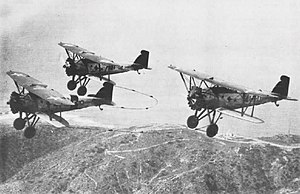Boeing F2B
| Boeing F2B | |
|---|---|
 The Three Seahawks at a demonstration |
|
| Type: | Carrier aircraft |
| Design country: | |
| Manufacturer: | |
| First flight: |
November 3, 1926 |
| Commissioning: |
1928 |
| Number of pieces: |
32 and 1 prototype |
The Boeing F2B (factory designation Model 69) was a double-decker of the United States Navy in the 1920s, which particularly by its use in Three Seahawks became known -Kunstflugteam.
construction and development
The F2B was a direct development of the XP-8 (Model 66), but the Pratt & Whitney R-1340 B Wasp engine installation of the FB-6 was used. Boeing used this engine specifically for carrier missions. The fuselage and wing structure differed only slightly from that of the XP-8. The armament consisted of either two 7.62-mm machine guns or one 7.62-mm machine gun inside and one 12.7-mm machine gun outside; the lower wing had mounts for up to four 11 kg bombs, a fifth could be mounted under the fuselage.
Mission history
The prototype first flew on November 3, 1926 and was designated XF2B-1 by the US Navy. This reached a top speed of 247 km / h. This impressed the Navy so much that they ordered a total of 32 machines of this type. Since the large, streamlined spinner fairing was omitted from the production version, these were given an aerodynamically balanced rudder. The delivery to the Navy began on January 20, 1928 to the Fighter Squadron VF-1B and to the shortly before emerged from the VF-6B Bomber Squadron VB-2B . Both operated from the USS Saratoga (CV-3) . Although the Navy did not order any more F2Bs, Boeing built two more as Model 69Bs, one of which was exported to Brazil and one to Japan . However, the plane destined for Brazil crashed during the transfer flight.
Three Seahawks aerobatic team
In 1927 Lt. DW "Tommy" Tomlinson in the VB-2B naval squadron in San Diego, the aerobatic team with 3 Boeing F2B-1 machines. Their first unofficial appearance in January 1928 in San Francisco gave them the nickname "Suicide Trio". The first official appearance was from 8th to 16th September 1927 as representative of the US. Navy during National Flight Week at Mines Field . Lt. Tomlinson modified the carburetors so that they worked in any position in order to fly overhead. At the end of 1929, the Three Seahawks were disbanded when the pilots were ordered back to their unit.
variants
- XF2B-1
- (Model 69) Prototype with the Bureau Number (BuNo) A7385
- F2B-1
- (Model 69) Single-seat biplane for the US Navy, BuNos A7424 to A7455
- Model 69B
- 2 aircraft identical to the F2B-1, one each to Brazil and Japan.
Users
Technical specifications
| Parameter | F2B-1 data |
|---|---|
| Span: | 9.17 m |
| Length: | 6.98 m |
| Height: | 2.81 m |
| Wing area: | 22.57 m² |
| Engine: | Pratt & Whitney R-1340 -8 Wasp |
| Takeoff mass: | 1272 kg |
| Top speed: | 254 km / h |
| Summit height: | 6,555 m |
| Gradeability: | approx. 600 m / min |
| Range: | 507 km |
| Armament: | a Browning M2 and a Browning M1919 or two Browning M2 , four 11 kg bombs under the wings and one 11 kg bomb under the fuselage. |
See also
literature
- Paul Eden, Sophn Moeng: The Complete Encyclopedia of World Aircraft . London: Amber Books Ltd., 2002. ISBN 0-7607-3432-1 .
- Lloyd S. Jones: US Naval Fighters . Fallbrook CA: Aero Publishers, 1977. ISBN 0-8168-9254-7 .
- Gordon Swanborough, Peter M. Bowers : United States Navy Aircraft Since 1911 . Annapolis, MD: Naval Institute Press, 1976. ISBN 0-87021-968-5 .
